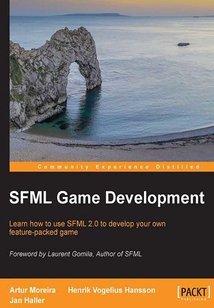舉報 

會員
SFML Game Development
最新章節:
Index
SFMLGameDevelopmentisafast-paced,step-by-stepguide,providingyouwithalltheknowledgeandtoolsyouneedtocreateyourfirstgameusingSFML2.0.SFMLGameDevelopmentaddressesambitiousC++programmerswhowanttodeveloptheirowngame.Ifyouhaveplentyofideasforanawesomeanduniquegame,butdon’tknowhowtostartimplementingthem,thenthisbookisforyou.ThebookassumesnoknowledgeaboutSFMLorgamedevelopment,butasolidunderstandingofC++isrequired.
目錄(85章)
倒序
- 封面
- 版權信息
- Credits
- Foreword
- About the Authors
- About the Reviewers
- www.PacktPub.com
- Preface
- Chapter 1. Making a Game Tick
- Introducing SFML
- A few notes on C++
- Developing the first game
- Game loops and frames
- Displaying sprites on the screen
- Summary
- Chapter 2. Keeping Track of Your Textures – Resource Management
- Defining resources
- Resources in SFML
- A typical use case
- An automated approach
- Error handling
- Generalizing the approach
- Summary
- Chapter 3. Forge of the Gods – Shaping Our World
- Entities
- Rendering the scene
- Updating the scene
- The view
- Landscape rendering
- Composing our world
- Integrating the Game class
- Summary
- Chapter 4. Command and Control – Input Handling
- Polling events
- Getting the input state in real time
- Playing nice with your application neighborhood
- A command-based communication system
- Customizing key bindings
- Summary
- Chapter 5. Diverting the Game Flow – State Stack
- Defining a state
- The state stack
- The state context
- Integrating the stack in the Application class
- Navigating between states
- The loading screen – sample
- Summary
- Chapter 6. Waiting and Maintenance Area – Menus
- The GUI hierarchy the Java way
- Updating the menu
- The promised key bindings
- Summary
- Chapter 7. Warfare Unleashed – Implementing Gameplay
- Equipping the entities
- Creating enemies
- Adding projectiles
- Picking up some goodies
- Collision detection and response
- An interacting world
- Victory and defeat
- Summary
- Chapter 8. Every Pixel Counts – Adding Visual Effects
- Defining texture atlases
- Low-level rendering
- Particle systems
- Animated sprites
- Post effects and shaders
- Summary
- Chapter 9. Cranking Up the Bass – Music and Sound Effects
- Music themes
- Sound effects
- Sounds in 3D space
- Summary
- Chapter 10. Company Atop the Clouds – Co-op Multiplayer
- Playing multiplayer games
- Interacting with sockets
- Data transport
- Network architectures
- Creating the structure for multiplayer
- Working with the Server
- Taking a peek in the other end – the client
- Latency
- Cheating prevention
- Summary
- Index 更新時間:2021-08-13 17:11:26
推薦閱讀
- Go Web編程
- Three.js開發指南:基于WebGL和HTML5在網頁上渲染3D圖形和動畫(原書第3版)
- FFmpeg入門詳解:音視頻流媒體播放器原理及應用
- Vue.js 3.0源碼解析(微課視頻版)
- 深度學習:算法入門與Keras編程實踐
- C語言課程設計
- Elasticsearch Server(Third Edition)
- Yii Project Blueprints
- 多媒體技術及應用
- C/C++代碼調試的藝術(第2版)
- 面向對象程序設計教程(C#版)
- RPA開發:UiPath入門與實戰
- IBM Cognos Insight
- Hands-On Exploratory Data Analysis with Python
- MATLAB程序設計及應用
- HTML5 for Flash Developers
- Offline First Web Development
- 程序員面試筆試寶典
- Hands-On RESTful API Design Patterns and Best Practices
- Android從入門到精通(微視頻精編版)
- Matplotlib 2.x By Example
- INSTANT HTML5 Local Storage How-to
- Python網絡爬蟲與數據分析從入門到實踐
- Python密碼學編程(第2版)
- Practical Test:Driven Development using C# 7
- 數據結構(C語言版)(第2版)
- H5安全開發實踐教程
- C# 8.0本質論
- Learning iOS UI Development
- TypeScript 2.x for Angular Developers

